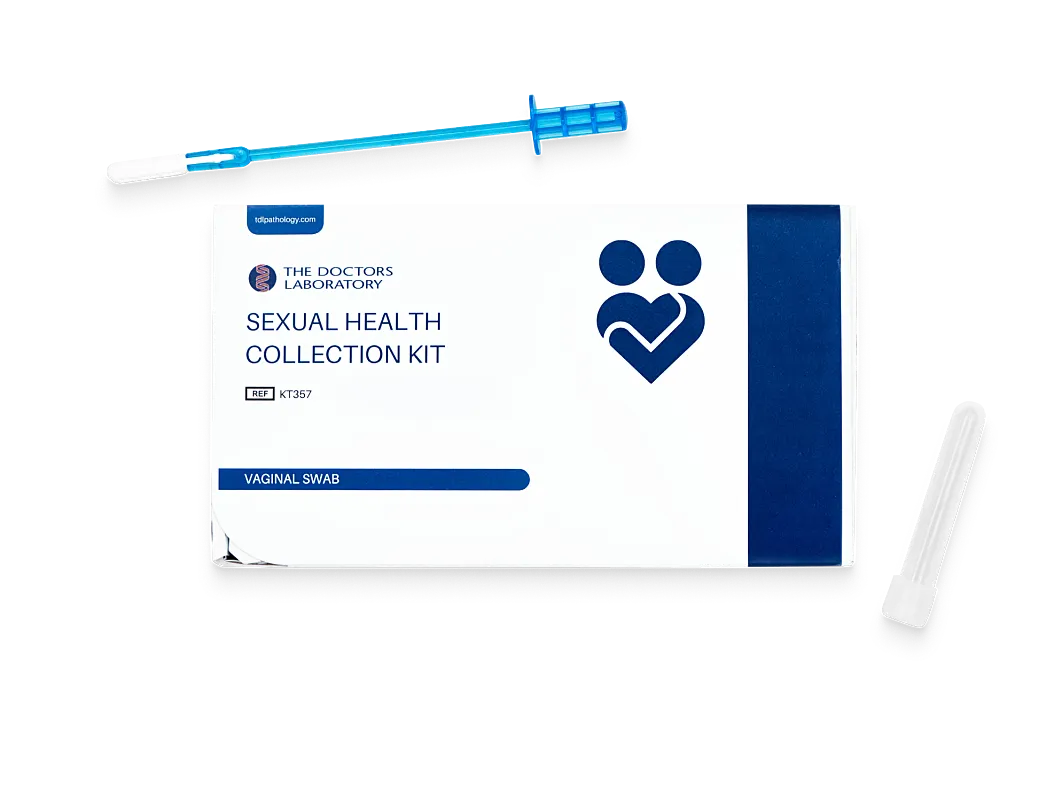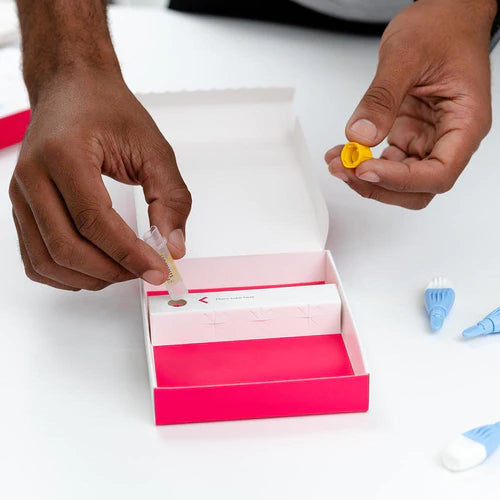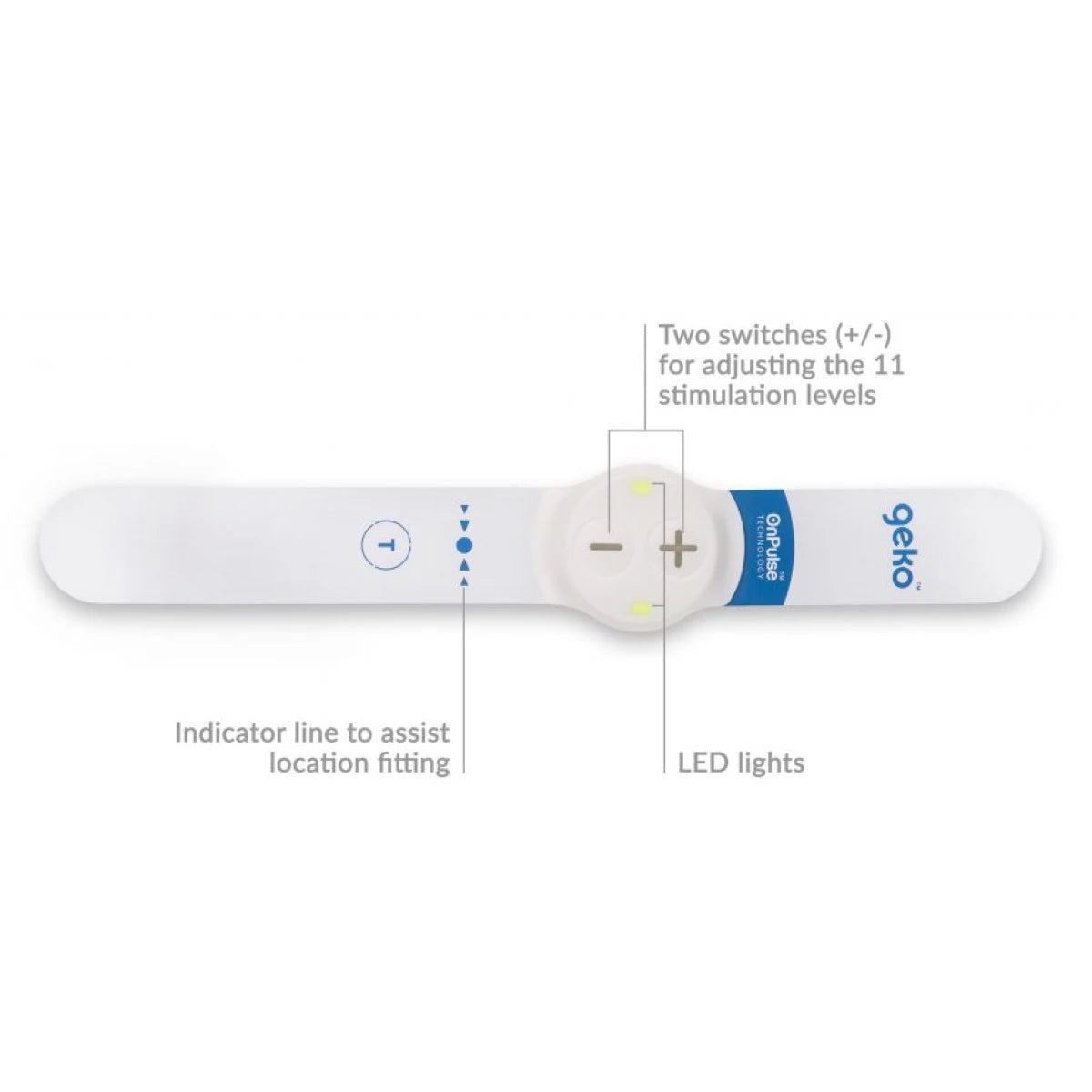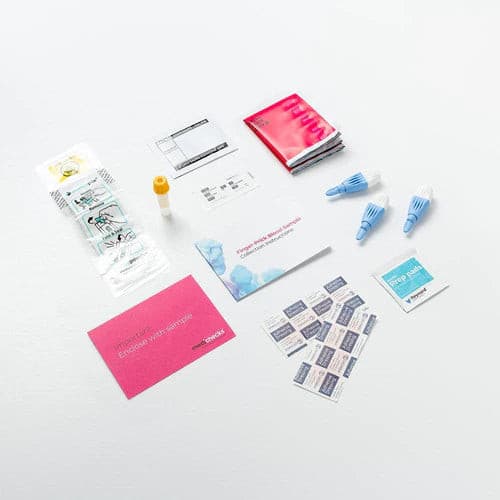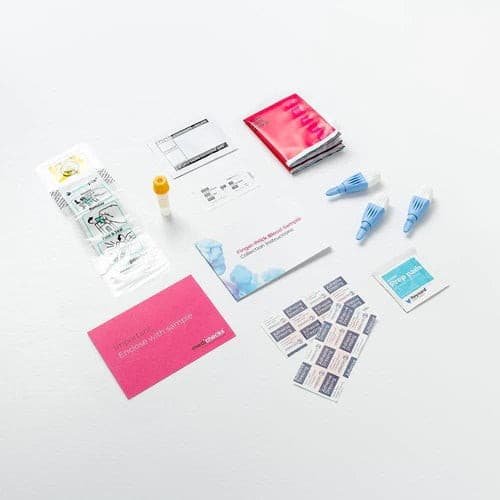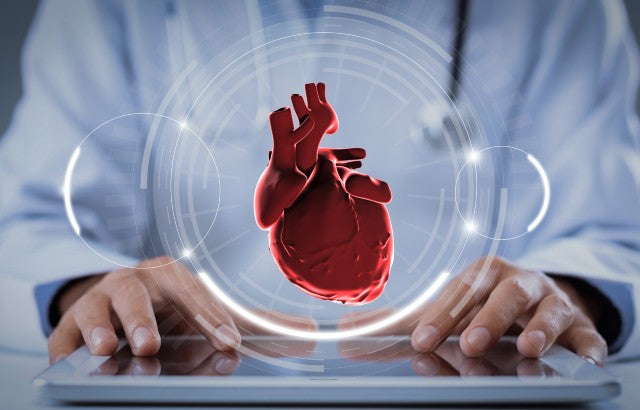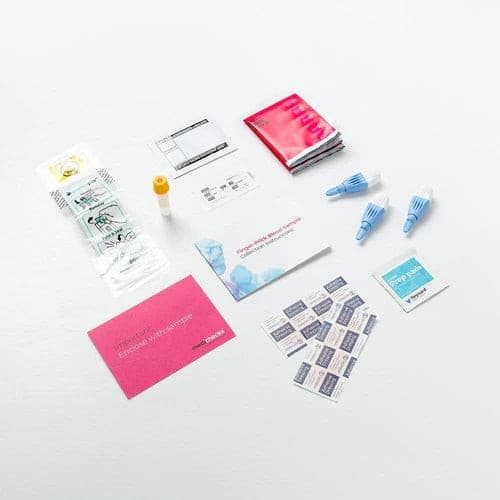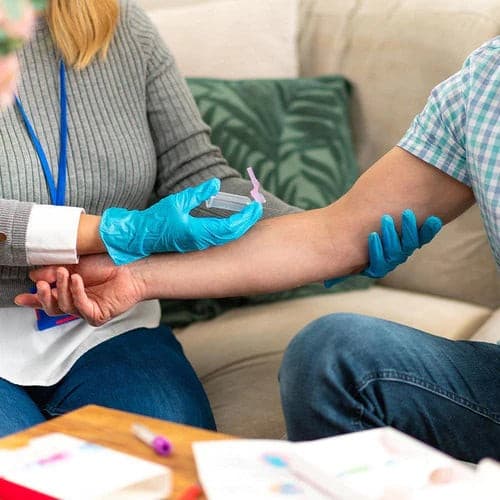Why People Choose Us

Quick & Easy
No appointment or long waiting times

Discreet Packaging
Plain packaging with no medical stamps or marks

Confidential Service
Your information stays with us and private payment

UK Medication
Dispensed by registered UK pharmacists
Hormones (5 Biomarkers)
Every bodily function, including development, metabolism, reproduction, and sleep cycles, is controlled by hormones.
Your mood and energy levels, as well as your fertility and libido, can all be negatively impacted by even a slight hormonal imbalance.
Chemical messengers known as hormones are produced in your glands and delivered into your bloodstream. Your body receives instructions from them on how to control your appetite, growth, mood, and reproduction.
In general, they maintain the body's equilibrium and functionality. Hormone imbalances are frequently treated with hormone replacement therapy or by altering one's lifestyle. Throughout the day and for women during the menstrual cycle, hormone levels change.
Testosterone
A hormone called testosterone is responsible for male features. It plays a part in controlling bone mass, fat distribution, muscular mass, strength, the creation of red blood cells, and the production of sperm in men.
It also helps to regulate sex drive. Men's testicles and, to a much lesser extent, women's ovaries both produce testosterone. Although lower than normal amounts of testosterone can occur at any age and can result in low libido, erectile dysfunction, difficulties gaining and retaining muscular mass, and lack of energy, testosterone levels in males naturally fall after age 30.
Even though testosterone levels in women are significantly lower than in men, it is still vital for the same reasons—it affects libido, how fat and muscle are distributed, and how red blood cells are formed. Because reference ranges are dependent on the population being tested, they will all somewhat vary between laboratories. 95% of men will fall inside the usual range, which has been determined.
We follow the British Society for Sexual Medicine's (BSSM) recommendations for greater consistency, which state that low testosterone can be diagnosed when levels are consistently below the reference range and that levels below 12 nmol/L may also be considered low, particularly in men who also experience symptoms of low testosterone or who have low levels of free testosterone.
FSH
The pituitary gland produces the hormone follicle stimulating hormone (FSH), which is crucial for both men and women in the development of sperm and eggs.
FSH increases the growth of follicles within the ovaries in the first half of the menstrual cycle in women. Oestradiol levels will rise thanks to each of these follicles.
Follicle stimulating hormone levels fall throughout the second half of the menstrual cycle as one follicle becomes dominant and is discharged by the ovary (ovulation). In men, FSH stimulates immature sperm cells to mature into sperm by acting on the seminiferous tubules of the testicles.
LH
The pituitary gland produces the luteinizing hormone (LH), which is crucial for both male and female reproduction. It controls the menstrual cycle in women and peaks just before ovulation. It increases testosterone production in men.
Prolactin
The pituitary gland produces the hormone prolactin, which is important for reproductive health.
Prolactin levels can skyrocket in pregnant and nursing women, and its main function is to boost milk production after delivery.
Free Androgen Index
The quantity of testosterone that is free (unbound) in the bloodstream is calculated using the free androgen index (FAI).
The majority of testosterone is protein-bound to albumin and the sex hormone-binding globulin, making it unavailable to interact with cells in the body. The FAI is a formula that measures the quantity of testosterone that is available to act on the body's tissues and is based on the ratio of testosterone to SHBG.
Women can predict the likelihood of polycystic ovarian syndrome using the free androgen index. Free testosterone in men provides a more accurate representation of testosterone level.
Proteins (4 Biomarkers)
Proteins are essential for muscle growth as well as the operation of cells and tissues. Blood proteins are measured to assist in the diagnosis of various illnesses, such as liver or kidney disease.
It is common practise to analyse proteins to determine how much of a specific hormone is bound to a protein or free and thus available to your cells. Proteins also transport other chemicals, such as hormones, throughout the blood.
Dehydration is a common cause of elevated proteins, but they can also be a sign of other health issues. A significant protein deficiency may be a sign of malnutrition or malabsorption.
Globulin
The term "globulin" refers to a variety of proteins that the liver and immune system create. While certain globulins transport metals like iron in the blood, others bind with haemoglobin.
In addition, there is a specific class of globulin called an immunoglobulin, which is another name for an antibody and aids in the body's defence against infection.
Albumin
A protein called albumin is mostly produced in the liver. It aids in generating the osmotic pressure necessary to keep water in the blood.
It is crucial for tissue growth and repair and aids in the transportation of nutrients, medicines, and other chemicals via the blood.
By evaluating albumin levels in the blood, we can determine how much hormone is available to your tissues. Albumin also transports hormones throughout the body.
Total Protein
The total protein in your blood is the sum of the proteins albumin and globulin. Among their many jobs, albumin and globulin keep blood in vessels, deliver nutrients, and combat infection.
A liver or renal problem as well as malnutrition may be indicated by abnormal levels.
SHBG
The majority of the sex hormones, including testosterone, oestrogen, and dihydrotestosterone (DHT), are bound to Sex Hormone Binding Globulin (SHBG), rendering them inactive in your cells.
The amount of free or unbound hormones, which are biologically active and available for usage, can be determined by measuring the level of SHBG in your blood.
Thyroid Hormones (2 Biomarkers)
A gland at the front of your neck called the thyroid makes hormones that aid in regulating your metabolism.
Your thyroid may generate too little or too many thyroid hormones, and either situation can cause crippling symptoms. Lethargy, weight gain, dry skin, and hair are typical symptoms of an underactive thyroid, while nervousness and anxiety are typical signs of an overactive thyroid, as well as weight loss.
Once detected, thyroid disorders can be treated, but even then, it's crucial to keep an eye on your thyroid hormone levels to make sure they stay at their ideal levels.
TSH
The thyroid is a gland located near the base of the neck that regulates several metabolic processes, including substrate turnover, heart function, muscle physiology, and energy expenditure.
Thyroid dysfunction can cause either overproduction of hormones (overactive) or underproduction of hormones (underactive), both of which can lower athletic performance. The pituitary gland produces Thyroid Stimulating Hormone (TSH), which stimulates the thyroid gland to create the thyroid hormones thyroxine (T4) and triiodothyronine (T3).
As part of a neuroendocrine cascade, thyroid hormone synthesis occurs. Thyrotropin releasing hormone (TRH) is released first in the hypothalamus, where it causes the pituitary to release thyroid stimulating hormone (TSH).
To release the hormones T3 and T4, this attaches to thyroid gland cells (thyroxine). Additionally, peripheral tissues convert T4 into T3, the thyroid hormone with greater activity.These hormones are essentially what regulate your body's metabolism.
Negative feedback loops typically maintain a tight balance between all of these levels. Thyroid hormone over- or under-secretion can be a sign of abnormal thyroid function. These disorders frequently have an autoimmune component, which can frequently be detected by looking at your thyroid antibodies in more sophisticated thyroid tests.
Free Thyroxine
One of the two hormones that the thyroid gland produces is thyroxine (T4). It accelerates the rate at which your metabolism functions.
The majority of T4 in the blood is bound to carrier proteins, but this test solely measures free, or unbound, T4, which is active in the body.
Inflammation (1 Biomarker)
When your immune system is triggered to purge your body of external invaders or irritants and to guard against tissue damage, inflammation results.
Inflammation frequently manifests as heat, redness, swelling, and discomfort. An acute or persistent inflammation might exist. Infection or injury are common causes of acute inflammation, which appears for a few days before going away.
Long-term diseases including arthritis, inflammatory bowel disease, or asthma can lead to chronic inflammation. Certain proteins that are elevated in the blood as a result of inflammation can be tested to determine the level of inflammation and, in some cases, its underlying cause.
CRP-HS
The C-Reactive Protein (CRP) is a marker of inflammation that is used to determine whether there is inflammation in the body but not where it is situated.
A test known as High Sensitivity CRP (CRP-hs) is used to find low-level inflammation that may harm blood vessels and cause a heart attack or stroke. There is a great deal of inflammation at the site of a significant injury. The swelling around a twisted ankle is easy to picture. Your CRP-hs will increase with any damage of this nature.
But frequent exercisers also run the danger of developing chronic low-level inflammation, which can harm their performance.
We draw this picture using CRP-hs, CK, and your complete blood count (see the articles on the liver and complete blood count). When you are rested for the test, inflammatory markers like CRP-hs provide the most insight; otherwise, they may be increased from recent exercise.
Red Blood Cells (7 Biomarkers)
The most prevalent form of blood cell, the red blood cell, is responsible for transporting oxygen to your tissues through your circulatory system.
Your bone marrow continuously produces red blood cells to replace those that are lost as a result of bleeding or cell ageing.
Your red cell count should remain consistent, but some health issues can result in abnormally few or excessively numerous red cells, abnormally fast cell death, or abnormally shaped red cells.
The amount of oxygen given to your tissues is affected if you are not creating enough red blood cells, which causes anaemia and its accompanying symptoms of weariness and pale skin. Headaches, blurred vision, and an enlarged spleen can all be symptoms of excessive red blood cell production.
Haematocrit
The haematocrit (HCT) scale measures how much space (volume) red blood cells occupy inside the blood.
Haemoglobin
Red blood cells contain the protein haemoglobin, which is responsible for the red colour of the blood and for carrying oxygen throughout the body.
This test gauges the blood's capacity to transport oxygen throughout the body by counting the amount of haemoglobin present.
Because they need to make sure that their muscles are getting enough oxygen, athletes and sports persons typically have higher oxygen demands than the normal person. In endurance and strength athletes, it is typical to detect haemoglobin levels at the higher end of the normal range.
MCH
The average amount of haemoglobin found in one of your red blood cells is measured by MCH (mean corpuscular hemoglobin).
MCHC
The average amount of haemoglobin in your red blood cells is called the MCHC (mean corpuscular haemoglobin concentration). Red blood cells use the chemical haemoglobin to carry oxygen throughout the body.
MCV
Your red blood cells' average size can be determined by your MCV (mean corpuscular volume).
This is crucial to evaluate because it can show how much oxygen your cells are probably transferring throughout the body.
Red Cell Count
Analyzing the quantity of red blood cells in the blood is known as red blood cell (RBC) counting.
Oxygen is transported by red blood cells from the lungs to the rest of the body, where it can be used as a source of energy for activities like breathing and moving about. Additionally, they transport the carbon dioxide that cells make back to the lungs for exhalation.
RDW
The red blood cell distribution width (RDW) reveals whether the sizes and shapes of your red blood cells are uniform across the board or vary.
Your red blood cells may grow in atypical sizes due to several blood disorders because, in general, cells are pretty uniform in size and shape. The size difference between the largest and the smallest red blood cell is determined by this test.
Clotting Status (2 Biomarkers)
Your bone marrow produces your clotting cells (platelets), which are crucial for regulating bleeding.
Thrombocytopenia is a condition that occurs when too few or too quickly damaged platelets are created. Immune problems, certain medications, liver illness, or continuous bleeding are all potential causes of this.
Thrombocytosis, often known as a high platelet count, can result from a number of illnesses, including problems with the bone marrow, infection, and inflammation.
Platelet Count
The smallest form of blood cell, called platelets or clotting cells, are crucial for blood coagulation.
The platelets enlarge, cluster, and eventually form a sticky plug (a clot) that aids in stopping bleeding when it occurs.
MPV
Mean Platelet Volume, or MPV, is a measurement of your platelets' typical size.
Blood cells that have been broken up into pieces are called platelets, and they help clots form. The production of platelets in your bone marrow is indicated by MPV.
White Blood Cells (6 Biomarkers)
The foundation of your body's immunological or defence system is made up of white blood cells.
They combat illnesses and shield your body from external substances like dangerous bacteria and germs. White blood cells are created from bone marrow stem cells and have a short lifespan of a few days.
The body is protected by five main types of white blood cells, each of which has a unique function. Your immune system and recent infections can both be diagnosed using the numbers of each of these categories of white blood cells.
White Cell Count
The White Blood Cell (WBC) Count calculates how many white blood cells are present in the blood. White blood cells are essential to the immune system of your body.
They combat illnesses and defend your body from invaders like dangerous bacteria and germs. To shield you from repeated infections with the same germ, they also develop a large number of antibodies and memory cells.
Basophils
White blood cells called basophils guard your body against bacteria and parasites like ticks. They additionally contribute to allergic responses.
Eosinophils
White blood cells called eosinophils are in charge of eliminating parasite infections and controlling inflammation to identify an infected spot. They also have an impact on asthma and allergies.
Lymphocytes
White blood cells called lymphocytes defend the body against viral and bacterial illnesses.
They are a subgroup of white blood cells that play a role in the body's more focused response to infections, which is able to recognise and classify various foreign organisms that enter the body.
They create antibodies and memory cells to aid in preventing further infections from the same germ in addition to combating infection. T cells, B cells, and natural killer cells are examples of lymphocytes.
Monocytes
White blood cells called monocytes engulf and eliminate pathogens as well as dead or damaged cells from our blood.
These cells' activity contribute to the heat and swell of inflammation.
Neutrophils
White blood cells known as neutrophils are in charge of assisting your body in the fight against illness. If your neutrophil count is low, you may be more susceptible to disease and infection.
Iron Status (1 Biomarkers)
Ferritin
A complex globular protein called ferritin is used to store iron in an inactive form. The ferritin releases its iron for usage as your iron reserves get depleted.
You will run out of iron if your ferritin levels drop, and your ability to make red blood cells in your bone marrow will also suffer.
Thus, ferritin provides a reliable indication of your iron reserves. Ferritin can rise at times of infection, inflammation, or trauma because it is an acute phase protein as well.
Liver Health (3 Biomarkers)
One of your body's most vital organs, the liver performs a variety of tasks including converting food into energy, eliminating waste and toxins, and producing and regulating some hormones.
Through overeating, drinking alcohol, and contracting viral hepatitis, your liver can become inflamed and gradually harmed. Although your liver has extraordinary regeneration capabilities, liver disease is irreversible once inflammation has resulted in scarring (cirrhosis).
Blood tests evaluate the levels of several enzymes, and if they are elevated, it may be a sign that your liver is inflamed.
ALT
The liver produces the enzyme alanine transferase (ALT), which can indicate liver damage brought on by drugs, alcohol, or viruses.
GGT
The liver enzyme gamma GT, sometimes referred to as gamma-glutamyl transferase (GGT), is increased in conditions affecting the liver and bile ducts.
To differentiate between liver and bone diseases, it is utilised in conjunction with ALP. As it is elevated in 75% of heavy drinkers, gamma GT is also used to diagnose alcohol consumption.
ALP
An enzyme called alkaline phosphatase (ALP) is mostly present in the liver and bones. Its measurement can reveal whether a person has any active liver, gallbladder, or bone conditions.
Cholesterol Status (1 Biomarkers)
A fatty molecule called cholesterol is present in the blood and is crucial for the proper functioning of the body's cells.
But having too much cholesterol in your blood can seriously harm your health since it makes you more likely to experience a heart attack or stroke.
Numerous variables increase the risk of cardiovascular disease, and we continue to learn more about the intricate biochemical mechanisms that trigger a heart attack.
However, even then, it is not so straightforward because there are various forms of cholesterol, some of which are more dangerous than others. High levels of cholesterol have long been recognised to increase your risk.
In addition to coming from the food we eat, cholesterol is also produced in the liver. Diet, family history, obesity, and inactivity all have a negative effect on cholesterol levels.
Total Cholesterol/HDL
By dividing your total cholesterol value by your HDL cholesterol level, you can get your cholesterol/HDL ratio.
It serves as a gauge of cardiovascular risk since it provides useful information about the percentage of "good" cholesterol in your total cholesterol (i.e. high-density lipoprotein, HDL).
The cholesterol/HDL ratio is used by heart disease risk calculators (like QRisk) to estimate your risk of suffering a heart attack.
Kidney Health (3 Biomarkers)
Waste materials and extra fluid are taken out of your blood by your kidneys. Examining the levels of waste products in the blood as well as the levels of electrolytes, which control fluid in the body, can be used to gauge how effectively they are performing their duties.
Early kidney disease signs are usually nonexistent, so it's crucial to keep an eye on kidney function, particularly if you have diabetes, high blood pressure, or a close relative who has the condition.
Urea
When proteins are broken down in the liver, the body excretes urea as waste. After being created, urea is delivered to the kidneys, where it is removed from the blood and eliminated from the body as urine.
Thus, monitoring urea levels in the blood can provide insight into the health of the liver and kidneys. It is crucial to remember that results may still come back as normal even if one kidney is severely damaged but the other is in perfect working order.
Creatinine
The regular breakdown of muscles produces the chemical waste molecule creatinine. Therefore, athletes are capable of higher levels than the normal person.
Since creatinine is excreted by the kidneys, it can be used to diagnose renal disease and is a reliable indicator of kidney function.
EGFR
The estimated glomerular filtration rate (eGFR), which calculates how much blood is filtered through the kidneys, measures how well the kidneys are functioning.
The kidneys' glomeruli are microscopic filters that remove waste materials. Kidney function may be hampered if these filters do not operate adequately.
Your age, gender, ethnicity, and serum creatinine levels are used to compute your estimated glomerular filtration rate, or eGFR.
Easy Steps for your Medicine

Complete a consultation.
With complete privacy and confidentiality your form is checked by a pharmacist independent prescriber.
Choose your treatment.
From the list approved by the prescriber, choose your preferred treatment and then wait for it to be dispensed by UK Meds online pharmacy.
Receive your delivery
With next day delivery options available, you can have your treatment sent out to you discreetly within hours.Our Happy Customers
Rated Us for our Service Excellence
 Dispensed by Regulated UK Pharmacists
Dispensed by Regulated UK Pharmacists

 How it works
How it works Help
Help Account
Account
 Basket
Basket










